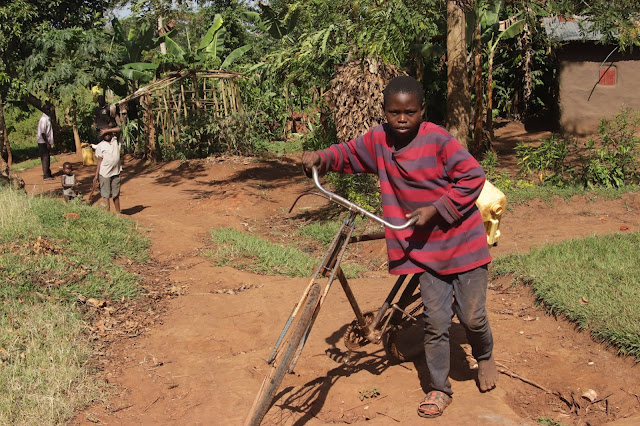Day 5 - Looking for our brothers and sisters in Kibale
‘When, in the early 1960s, I brazenly used
such words as 'childhood', 'adolescence', 'motivation', 'excitement', and
'mood' I was much criticized. Even worse was my crime of suggesting that
chimpanzees had 'personalities'. I was ascribing human characteristics to
nonhuman animals and was thus guilty of that worst of ethological sins
–anthropomorphism ‘(Jane Goodall - 1993)
What Dian Fossey meant to the gorillas, Jane Goodall
meant to the chimpanzees. She studied the social and family life of the
chimpanzee for 40 years. Like Dian Fossey, she lived very close with the
animals. Until now, she is the only person accepted as one of them. She was the
lowest ranked in a group of chimpanzees for 22 months. Because she was so close
to her subject of study, in contrast to the scientific approach of identifying
the animals by assigning numbers, she gave names to the animals. This
humanization made science rather suspicious of her descriptions of chimpanzee
behavior in terms of human actions. However, her approach proved to be a direct
hit and is now widely used by biologists. Due to her personal approach, she
observed very human behavior among the chimpanzees: hugs, kissing, pat on the
back and even tickling. All actions that we consider to be human. In addition,
she also discovered that chimpanzees make tools to make eating easier. Modern science
classifies chimpanzees as the closest living relatives of humans. They show
just under 99% of human behavior.
This afternoon we head into the forests of Kibale NP to
meet our brothers and sisters. The Kibale NP is located just next to the Queen
Elizabeth NP and is home to a large number of monkey species, including the
endangered red colobus and the L'Hoest monkeys. But the area is best known as a
habitat for large groups of chimpanzees. As with the gorillas, we also get one
hour with them. But unlike the gorillas who settle down for an elaborate meal,
the chimpanzees are much more agile. They like sweets, fruits, a fresh leaf,
but also seeds, blossom, bark and tree sap. In short, everything that is up for
grabs. They are particularly big fans of the fruits of the trees under the
collective name ficus, of which the best-known example is the fig. And for
their meals and snacks you will find them high in the tops of the trees. Kibale
NP is a rainforest and here too the area is dense. It will not be an epic hike
like our trip to the gorillas, but not a walk in the park either. We are still
at high altitude, but fortunately we do not have to overcome large differences
in altitude. It is especially difficult to navigate between the protruding
branches, gripping vines and treacherous roots. Here and there we have to cross
a hole in the ground or a tree trunk. In the distance we see dozens of tourists busy with cameras. They
got them. In the dence bushes, we see black shadows of chimpanzees.
Even though
they are not as big as gorillas, they are still impressive animals. And indeed,
you immediately see human behaviour. They scratch where its itches, absorb the
environment and then continue walking with their chimpanzee brother. Another
seems to be hiding from us in the dense foliage, but we manage to catch a brief
glimpse of him. Chimpanzees are champion climbers with their long arms and
short legs. We get an example of that when one of our relatives discovers a
delicacy in a tree and climbs up like a spear. A tasty fig is gobbled quickly.
Do I actually see starry lights in his eyes?
Other chimpanzees stick to nice
green leaves, relaxing on the ground. There is no shortage of leaves in a
tropical forest, you will find them in all sizes and weights. Even though these
chimpanzees are used to the proximity of humans, unlike the gorillas, you
notice a certain nervousness in them. As soon as they seem to become aware of
their surroundings and therefore also of the crowd, they run away as quickly as
possible. Nor can I get rid of the impression that we are also wind them up, by
chasing them every time. I wouldn't call it a serene meeting with our
relatives. It becomes even less serene when I suddenly find myself on the
flight path of a chimpanzee. The animal seems to run away from a horde of
tourists and comes rushing in. Not knowing what to do, I try to avoid him, but
I shouldn't have. The animal scrapes by. Phew, that was really a close
encounter.
Thanks to Jane Goodall, we understand these animals
better, but do they understand us? Probably they do not see us as their closest
relatives, but rather instinctively as the unknown enemy. We may not chase them
with guns, but at least we chase them with an arsenal of photo cameras, smartphones
and film material whereby we also turn around each other for the best place. We
look like a bunch of professional paparazzi who have insight on a scoop. The
nervousness that we clearly evoke in them raises even more questions for me.
Such as whether it is a good idea to go on a chimpanzee trekking with a group
of dozens of tourists who figuratively plunge onto their prey like sharks who
have smelled blood. It would be better to observe these animals in peace in
limited groups. In a few days we have another chimpanzee hike on the program. I
can only hope that at least there serenity prevails. Brothers and sisters,
thanks for tolerating the person who likes to be superior, but sometimes
behaves like an animal. All my best for the future.





Comments
Post a Comment